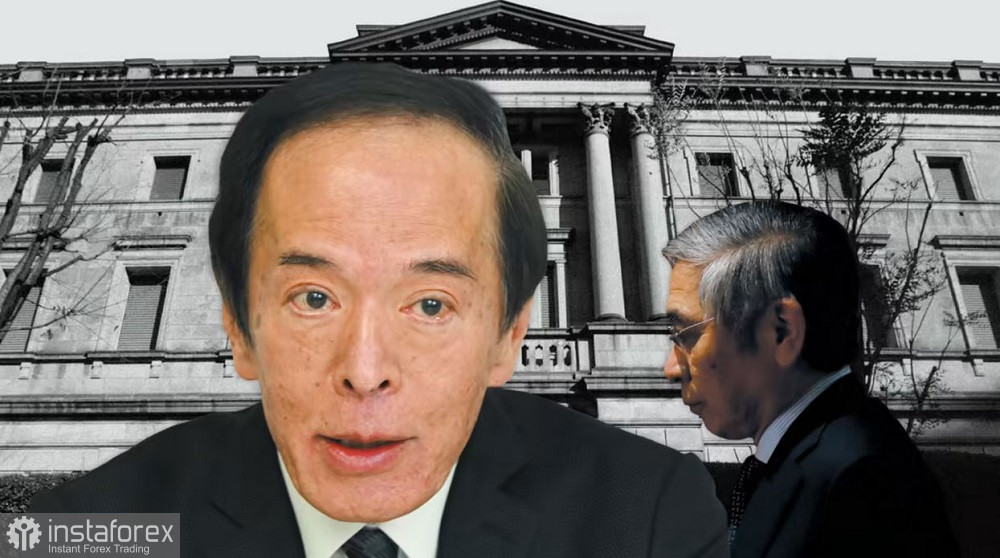The USD/JPY pair continues to systematically move upward towards the 135.50 resistance level, which corresponds to the upper line of the Bollinger Bands indicator on the daily chart. The latest events that took place on both sides of the Pacific Ocean supported the buyers of the pair, putting an end to the downward trend. It is extremely unlikely that the price will return to the area of 127–128 figures in the foreseeable future since the priority of the upward scenario is obvious, and it is due not only to the strengthening of the greenback, but also to the weakening of the yen.
Ueda is Kuroda's successor
Exactly a week ago, on February 14, the Japanese government officially nominated former University of Tokyo professor and central bank board member Kazuo Ueda as governor of the Bank of Japan. It cannot be said that this news became a sensation: the corresponding insider was leaked to the media a few days before the official announcement. Initially, Ueda was perceived as a potential hawk, at least compared to Haruhiko Kuroda, who is an advocate of ultra-loose monetary policy. But these hopes, tentatively, were not justified. The 71-year-old successor announced that he would stick to the course outlined by Kuroda. And although many experts doubt that Ueda will really implement an ultra-loose monetary policy (against the backdrop of persistently high inflation), the situation "at the moment" does not favor the yen.

It is likely that the central bank will indeed face the need to tighten monetary policy parameters, but in this case this will be a forced step, and not a programmatic action of the new head of the central bank. Recall that some other favorites of the pre-election race directly stated that after taking office, they would take measures to abolish the control of the yield curve and, possibly, in the future, they would lead the country out of the zone of negative rates. In the case of Ueda, this scenario will be extended in time, if at all, on the agenda.
Such a fundamental disposition allows USD/JPY buyers to slowly but surely move upward to the area of the 135th figure.
Note that Ueda will give a speech in the upper house of parliament on February 27. On this day, deputies will hold hearings to approve his candidacy. Kuroda's successor's keynote speech could have a strong impact on the yen, especially if the tone of the rhetoric becomes more hawkish about overall market expectations. However, judging by Ueda's previous statement, this scenario looks unlikely.
The yen will follow the greenback
The so-called "Ueda factor" will keep USD/JPY traders on their toes, but at the same time it will not directly affect the dynamics of the pair until February 27. During such uncertainty, the pair focuses primarily on the behavior of the U.S. currency, which in turn is waiting for the key macroeconomic release of the current week. We are talking about the basic price index of personal consumption expenditures (PCE) in the United States. This inflation indicator is monitored especially closely by the Fed, which is why market participants are paying attention to it, especially in light of recent events.
Recall that the inflation reports published in the U.S. last week alarmed members of the Federal Reserve. The Consumer Price Index and the Producer Price Index were unexpectedly in the green zone, indicating that the rate of decline in U.S. inflation has slowed. If the core price index for personal consumption expenditure also shows a positive trend after months of decline, the dollar could gain significant support. The year-on-year rate is projected to decline to 4.3% for the fourth straight month. But if, contrary to expectations, the index suddenly "rears its head," the greenback will strengthen its position across the market, including in pairing with the yen.
Conclusions
The first comments of the likely successor of the current head of the Bank of Japan, Kazuo Ueda, put pressure on the yen, but it is too early to draw final conclusions. On February 27, he will deliver his keynote speech, which will largely determine the fate of the yen in the medium term. To date, the Japanese currency paired with the dollar is forced to follow the greenback, which reacts to the hawkish statements of the Fed. The underlying PCE index, which will be released on Friday, may provoke price turbulence for the USD/JPY pair, especially if it comes out in the green zone (in this case, the pair may consolidate within the 135th figure).
From a technical point of view, the USD/JPY pair on the four-hour chart is located between the middle and upper lines of the Bollinger Bands indicator. The support level is located at 133.50, which corresponds to the lower line of the Bollinger Bands, coinciding with the Kijun-sen line. The nearest resistance level is the upper line of the Bollinger Bands on the same timeframe – this is the mark of 135.00. The main price barrier is the target 135.50 (the upper line of the Bollinger Bands on D1). Given the information background favorable for the greenback, longs for the pair are a priority, but it is advisable to make trading decisions after the report on the growth of the PCE index.





















